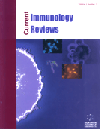- Home
- A-Z Publications
- Current Immunology Reviews (Discontinued)
- Previous Issues
- Volume 2, Issue 4, 2006
Current Immunology Reviews (Discontinued) - Volume 2, Issue 4, 2006
Volume 2, Issue 4, 2006
-
-
Hepatitis C Virus and Dendritic Cells
More LessA majority of hepatitis C virus (HCV) infected individuals become chronically infected. There are approximately 175 million patients chronically infected with HCV worldwide. Multispecific and vigorous cellular immune responses against HCV antigens have been suggested to play a significant role in viral clearance. Patients with chronic HCV are unable to prime and/or maintain vigorous T cell responses which are required to cl Read More
-
-
-
Immune Mechanisms of Sublingual Immunotherapy and Mycobacterial Adjuvants in the Treatment of Allergic Disease
More LessAuthors: Nerin N. Bahceciler and Isil B. BarlanWhile safety and efficacy of specific immunotherapy (SIT) by the sublingual route in patients with allergic asthma/rhinitis have now been largely documented, the immunological mechanisms have only started to be investigated. Most likely, the allergen captured within the oral mucosa by Langerhans-like dendritic cells (DCs), subsequently mature and migrate to proximal draining lymph nodes, which then induce T lymphoc Read More
-
-
-
The Long Pentraxin PTX3, a Soluble Pattern Recognition Receptor Involved in Innate Immunity,Inflammation and Female Fertility
More LessPentraxins are a family of evolutionarily conserved multifunctional pattern-recognition proteins characterized by a cyclic multimeric structure. Based on the primary structure of the subunit, the pentraxins are divided into two groups: short pentraxins and long pentraxins. C-reactive protein (CRP) and serum amyloid P-component (SAP) are the two short pentraxins. The prototype protein of the long pentraxin group is pentraxi Read More
-
-
-
Chemokines and Malaria Infection
More LessAuthors: Jenny Miu, Andrew J. Mitchell, Helen J. Ball and Nicholas H. HuntMalaria is a devastating disease of the tropics, with an estimated 3.2 billion people exposed to the threat of malaria. There are 1-3 million deaths annually, mostly of children in sub-Saharan Africa. Deaths due to malaria often arise from complications of Plasmodium falciparum infection, particularly cerebral malaria, but difficulties during pregnancy also contribute to the high incidence of morbidity and mortality. Cytokines Read More
-
-
-
Role of Vitamin A in T Cell Homing to the Gut
More LessBy Makoto IwataVitamin A supplementation significantly reduces infant mortality in developing countries, largely by reducing persistent diarrhea that is often aggravated by malnutrition. Vitamin A contributes to maintaining the integrity of mucosal epithelia and enhancing IgA responses in the gut. Recently, we found that vitamin A is essential for the homing of T cells to gut tissues. Retinoic acid (RA), an oxidative metabolite of retino Read More
-
-
-
NF-κB Activation by FcεRI-Mediated Signal Transduction
More LessAuthors: Stefanie Klemm and Jurgen RulandNF-κB is a master transcription factor in immunity and inflammation. It can be activated by a large variety of distinct cell surface receptors in response to multiple stimuli. NF-κB activation by the high affinity IgE receptor FcεRI is critical for proinflammatory cytokine production during mast cell activation and is crucial for allergic inflammatory diseases. Recent studies have identified two adaptor proteins, Bcl10 and Malt1, as Read More
-
-
-
Regulation of Adaptive Immunity by the Neurotransmitter Norepinephrine
More LessAuthors: Ian B. Fisher, Nicholas W. Kin, Jaclyn W. McAlees and Virginia M. SandersEndogenous physiological mechanisms are in place to regulate cell activity in organ systems to maintain host homeostasis when challenged. Antigenic exposure is an example of a challenge that disrupts host homeostasis. During this challenge, activated immune cells secrete cytokines that influence central nervous system activity, which in turn activates the peripheral sympathetic nervous system to release the neurotr Read More
-
-
-
Immunological Impediments to Developing a Blood Stage Malaria Vaccine
More LessAuthors: Michelle Wykes, Alberto Pinzon-Charry and Michael F. GoodThere are 300-500 million cases of malaria each year and of the more than one million people that die each year from malaria, most are children under 5 years of age. The cloning of malaria antigens in 1983 offered great hope of developing a viable subunit vaccine. While some subunit vaccines have shown great promise in model systems, an efficacious human vaccine is still not available. Immunological studies have sh Read More
-
Volumes & issues
Most Read This Month
Article
content/journals/cir
Journal
10
5
false
en


